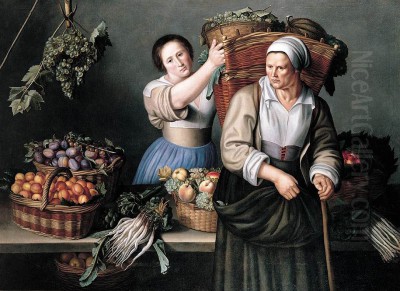
Louise Moillon (1610-1696) stands as one of the most significant and accomplished still life painters of the French Baroque era. In a period where history painting often overshadowed other genres, and female artists faced considerable barriers, Moillon carved out a distinguished career, celebrated for her exquisitely detailed and luminous depictions of fruit, flowers, and everyday objects. Her work, characterized by its refined realism, subtle handling of light, and serene compositions, brought a distinct French sensibility to a genre largely dominated by Dutch and Flemish masters at the time. This exploration delves into her life, artistic development, stylistic hallmarks, influential contemporaries, key works, and her enduring legacy in the annals of art history.
Early Life and Artistic Formation in a Protestant Milieu
Louise Moillon was born in Paris in 1610 into a family deeply embedded in the city's artistic and Protestant communities. Her father, Nicolas Moillon, was a landscape and portrait painter, as well as an art dealer. This familial environment undoubtedly provided Louise with her initial exposure to the world of art. Her mother, Marie Gilbert, also came from a family of goldsmiths, suggesting a household where craftsmanship and artistic skill were highly valued. Tragically, Nicolas Moillon passed away when Louise was still a child, around 1619.
Following her father's death, her mother remarried in 1620 to another painter and art dealer, François Garnier. Garnier specialized in still life painting, particularly fruit and flowers, and it is widely believed that he played a crucial role in Louise's formal artistic training. Growing up in the vibrant Saint-Germain-des-Prés quarter of Paris, an area known for its community of artists, including many Protestant refugees from the Southern Netherlands, Moillon was immersed in a rich artistic atmosphere. Her brother, Isaac Moillon, also became a painter, further underscoring the artistic inclinations of the family. This upbringing, surrounded by artists and the practice of art, provided a fertile ground for her burgeoning talent. The Protestant faith of her family would also play a significant role in her life, particularly in later years.
The Flourishing of a Still Life Virtuoso
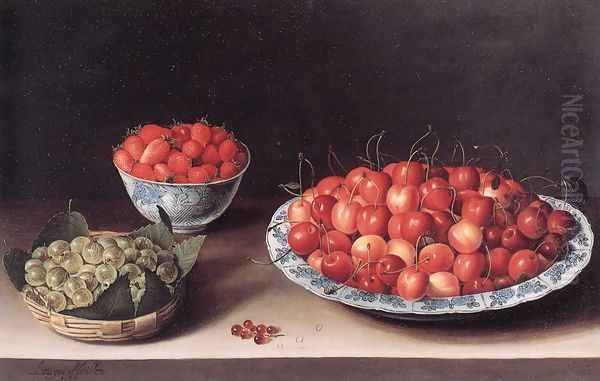
Louise Moillon's most prolific and arguably most brilliant period of artistic production occurred primarily in the 1630s, before her marriage. By the age of twenty, she was already creating works of remarkable maturity and skill. Her paintings from this decade demonstrate a profound understanding of texture, light, and composition. She specialized in still lifes, often depicting baskets or bowls laden with fruit, sometimes accompanied by vegetables or simple tableware, set against dark, neutral backgrounds.
Her approach was characterized by a meticulous attention to detail. Each piece of fruit – be it a velvety peach, a glistening grape, or a sharply defined cherry – was rendered with an almost tactile realism. She captured the subtle bloom on a plum, the delicate translucency of a currant, and the crispness of an apple with uncanny precision. This dedication to verisimilitude was a hallmark of the burgeoning still life tradition, yet Moillon imbued her subjects with a quiet dignity and an understated elegance that was distinctly her own. Her compositions, though seemingly simple, were carefully arranged to create a harmonious balance of form, color, and texture.
Artistic Style and Technical Mastery
Moillon's artistic style is a fascinating blend of influences, refined into a personal and recognizable idiom. While she was clearly aware of and influenced by the Netherlandish still life tradition, particularly the works of Flemish artists who had settled in Paris, her paintings possess a clarity and restraint that is often associated with French classicism.
Light and Shadow: A key feature of her work is her sophisticated use of light and shadow, often employing a form of chiaroscuro reminiscent of, though perhaps less dramatic than, Caravaggio. Light typically falls from one direction, illuminating the objects and casting subtle shadows, which enhances their three-dimensionality and creates a sense of depth. This focused lighting allows the textures and colors of the fruits and other elements to shine, giving them a luminous quality. She was particularly adept at rendering the way light reflects off different surfaces, from the dull sheen of a pewter plate to the glistening dewdrop on a leaf.
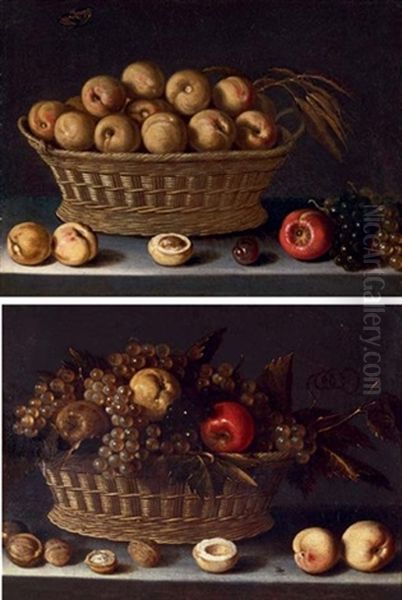
Compositional Serenity: Moillon's compositions are generally characterized by their orderliness and balance. Objects are often arranged on a simple wooden tabletop, sometimes partially covered with a white cloth. While some Dutch and Flemish still lifes of the period were opulent and overflowing, Moillon's tend towards a more austere and focused presentation. This simplicity allows the viewer to concentrate on the beauty of the individual objects and the artist's skill in depicting them. There is a stillness and a contemplative quality to her arrangements that invites quiet observation.
Trompe-l'œil and Textural Fidelity: While not always overt, elements of trompe-l'œil (trick of the eye) can be found in her work. The way a leaf might appear to extend just beyond the edge of the table, or the hyper-realistic rendering of a water droplet, creates a heightened sense of reality and draws the viewer into the painted space. Her ability to convey texture was exceptional. One can almost feel the fuzziness of a peach, the smoothness of a grape, or the crispness of an apple skin through her brushwork. This tactile quality was highly prized in still life painting.
Color Palette: Moillon's palette was rich yet controlled. She used deep reds, vibrant greens, luscious purples, and warm yellows, often set against dark, unifying backgrounds that made the colors of the fruit pop. Her understanding of color harmony contributed significantly to the overall aesthetic appeal of her paintings.
Influences and Artistic Contemporaries
Louise Moillon's artistic development was shaped by a confluence of influences, both direct and indirect, reflecting the vibrant artistic exchanges of 17th-century Paris. Her stepfather, François Garnier (c. 1600–1658 or 1672), was undoubtedly a primary influence, being a still life painter himself. His guidance would have provided her with foundational techniques and an understanding of the genre.
The Parisian art scene of her youth, particularly in Saint-Germain-des-Prés, was a melting pot of French and Netherlandish artists. She would have been exposed to the works of Flemish émigré painters who brought with them the rich tradition of Northern European still life. Artists such as Osias Beert the Elder (c. 1580–1623), Jacob van Hulsdonck (1582–1647), and Floris van Schooten (c. 1585/90–1656), though primarily active slightly earlier or concurrently in the Netherlands, established stylistic trends that permeated the genre and influenced painters across Europe, including those in Paris. Their meticulous detail and focus on the textures of fruit and tableware find echoes in Moillon's work.
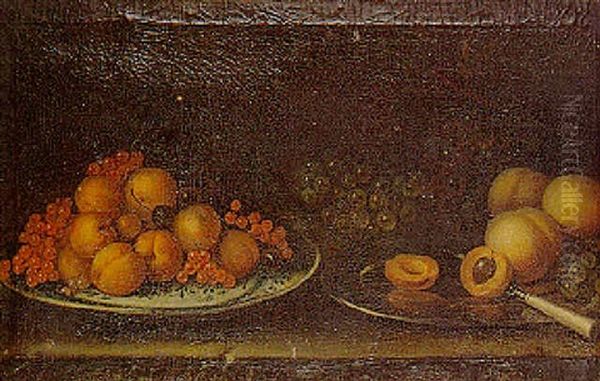
Another important female still life painter, Clara Peeters (1594–c. 1657), active in Flanders, was a contemporary whose work, known for its precision and often featuring elaborate "breakfast pieces," contributed to the growing prominence of still life. While direct influence is hard to prove, the shared dedication to realism and the elevation of everyday objects is notable.
Among her French contemporaries specializing in still life, Jacques Linard (1597–1645) is a significant figure. Linard, also a Protestant, was known for his refined still lifes of flowers, shells, and fruit. There is evidence of direct connection, as Moillon is documented to have collaborated with him on at least one painting, Still Life with Fruit (1641), where Linard may have painted the flowers and Moillon the fruit, a common practice for specialized artists. Another French contemporary working in a similar vein was Sébastien Stoskopff (1597–1657), an Alsatian painter known for his highly illusionistic still lifes, often with vanitas themes.
The influence of early Italian female still life painters like Fede Galizia (1578–1630) and Giovanna Garzoni (1600–1670) might also be considered, as their pioneering work in the genre contributed to its broader acceptance and development. Galizia, in particular, was known for her simple, elegant fruit compositions that predate Moillon's but share a similar sensibility.
The broader artistic currents of the Baroque, including the dramatic lighting popularized by Caravaggio (1571–1610) and his followers (the Caravaggisti), also indirectly influenced the way artists, including Moillon, approached light and shadow to create volume and drama, even in the quiet genre of still life. She also collaborated on at least one occasion with Pieter van Boecel (also known as Pierre van Boucle, c. 1610-1673), a Flemish still life painter active in Paris, further highlighting her connections within this artistic community. Her own father, Nicolas Moillon, though a landscape painter, would have provided her earliest artistic environment.
Notable Works and Their Characteristics
Louise Moillon produced a significant body of work, especially considering her most active period was relatively concentrated. Many of her paintings are now held in prestigious museums worldwide.
One of her most celebrated early works is _Still Life with Cherries, Strawberries, and Gooseberries_ (1630), housed in the Norton Simon Museum in Pasadena, California. Created when she was just twenty, this painting already showcases her remarkable skill. The fruits are arranged in simple baskets and directly on a wooden ledge, rendered with exquisite detail and vibrant color against a dark background. The play of light on the varied textures of the berries is particularly masterful.
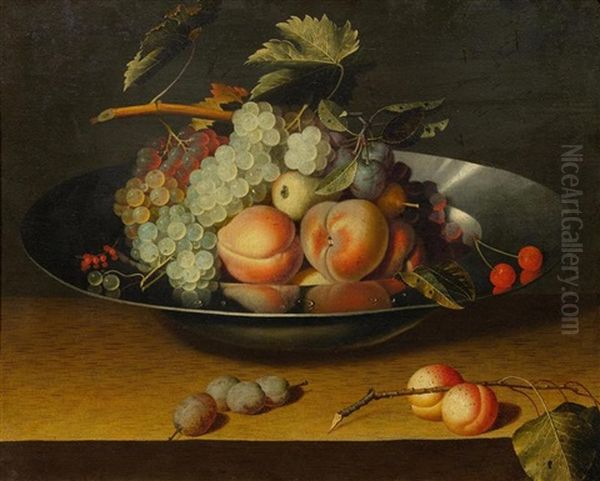
Another iconic piece is _Still Life with a Basket of Fruit and a Bunch of Asparagus_ (c. 1630), now in the Art Institute of Chicago. This work exemplifies her balanced compositions and her ability to render diverse textures, from the smooth skin of plums and apricots to the rougher surface of the asparagus spears. The wicker basket itself is a testament to her observational skills.
The Louvre Museum in Paris holds several of her works, including _Basket of Peaches and Grapes_ (1631) and _Still Life with a Basket of Fruit_ (also known as Corbeille de fruits, 1630). These paintings highlight her preference for showcasing fruit at its peak ripeness, arranged with an unpretentious elegance. The way light catches the bloom on the peaches or the translucence of the grapes is characteristic of her refined technique.
_The Fruit and Vegetable Seller_ (or The Fruit and Vegetable Coster, 1631), in the collection of the Victoria and Albert Museum, London, is a notable example of Moillon incorporating figures into her still lifes, a practice less common for her but one that adds a narrative dimension. Here, a young woman presents her wares, which are, as always, depicted with Moillon's signature precision and allure. This type of "market scene" was popular in Netherlandish art and shows Moillon engaging with broader genre conventions.
The Musée des Augustins in Toulouse is home to several important pieces, including _Corbeille de prunes et panier de fraises_ (Basket of Plums and Basket of Strawberries, 1632) and _Nature morte aux abricots_ (Still Life with Apricots, 1634). These works further demonstrate her consistent quality and her focus on the inherent beauty of natural produce. Her _Basket of Red Currants_ (1630) is often cited as one of her most perfect achievements in capturing the delicate nature of the fruit.
Her _Basket of Grapes, Apples, and Pears_ (1631), found in the Kimbell Art Museum, Fort Worth, Texas, is another fine example of her ability to create a harmonious and visually appealing arrangement from simple elements, with each fruit rendered distinctly and invitingly.
Patronage, Recognition, and Marriage
During her lifetime, Louise Moillon achieved considerable recognition for her artistic talents. Her paintings were sought after by notable collectors, including members of the French nobility and even King Charles I of England, who was a renowned connoisseur and patron of the arts. This level of patronage was significant for any artist, and particularly remarkable for a female painter in the 17th century. Her success underscores the quality of her work and its appeal to contemporary tastes. She was, by many accounts, one of the most celebrated still life painters in France during her active years.
In 1640, Louise Moillon married Etienne Girardot de Chancourt, a wealthy timber merchant from a Protestant family in Burgundy. Following her marriage, her artistic output significantly decreased. This was not uncommon for women artists of the period, as societal expectations often prioritized domestic responsibilities after marriage. However, she did not abandon painting entirely. Records indicate she continued to paint sporadically, with some works dated to the 1640s and even as late as 1674. The demands of family life, which included at least three children, likely limited the time she could dedicate to her art.
Later Life and the Impact of Religious Persecution
The latter part of Louise Moillon's life was profoundly affected by the changing religious climate in France. As a Protestant (Huguenot), she and her family had lived under the relative protection of the Edict of Nantes (1598), which granted substantial rights to Calvinist Protestants in a nation still considered essentially Catholic. However, this tolerance eroded over time, culminating in King Louis XIV's Edict of Fontainebleau in 1685, which revoked the Edict of Nantes.
This revocation unleashed a period of intense persecution for Protestants in France. They were faced with the choice of converting to Catholicism, fleeing the country, or risking severe penalties, including imprisonment, confiscation of property, or even death. Many Huguenot artists, artisans, and intellectuals chose exile, leading to a significant "brain drain" from France.
Louise Moillon's family was directly impacted. One of her sons was forced to flee to England. Louise herself, along with her husband and other children who remained in France, was compelled to convert to Catholicism. This forced conversion was a traumatic experience for many Huguenots, stripping them of their deeply held religious identity. While the exact details of her personal feelings about this are not extensively documented, it undoubtedly cast a shadow over her later years. She passed away in Paris in 1696, at the age of 86, reportedly from heart disease.
Rediscovery and Enduring Legacy
Despite the acclaim Louise Moillon received during her lifetime, her name and work, like those of many female artists of past centuries, gradually faded into relative obscurity after her death. The art historical canon, for a long time, tended to prioritize male artists and grander genres like history painting. Still life, despite its popularity, was often considered a "lesser" form of art.
However, the 20th and 21st centuries have witnessed a significant reassessment of art history, with concerted efforts to rediscover and re-evaluate the contributions of women artists and artists working in genres previously marginalized. Louise Moillon has been a beneficiary of this renewed scholarly interest. Art historians have recognized the exceptional quality of her work, her technical brilliance, and her important role in the development of French still life painting.
Today, Louise Moillon is acknowledged as a leading figure of the French Baroque and one of the foremost still life painters of her era. Her works are prized for their serene beauty, meticulous realism, and subtle psychological depth. They offer a window into the aesthetic sensibilities of 17th-century France and stand as a testament to the talent of an artist who excelled in a competitive field. Her paintings are now prominently displayed in major museums around the world, ensuring that her contribution to art history is recognized and appreciated by contemporary audiences. She not only mastered a genre but also brought to it a unique vision, characterized by quiet elegance and profound respect for the simple beauty of the natural world. Her legacy is that of a pioneer, a woman who, against the odds, forged a successful artistic career and left behind a body of work that continues to captivate and inspire.
Conclusion
Louise Moillon's journey from an artistically inclined Protestant family in Paris to one of the most esteemed still life painters of the French Baroque is a compelling narrative of talent, dedication, and resilience. Her meticulously rendered fruits and vegetables, bathed in subtle light and arranged with an innate sense of harmony, transcend mere representation. They are quiet meditations on the beauty and transience of nature, executed with a technical finesse that places her among the masters of the genre. Influenced by her familial artistic environment and the broader currents of Netherlandish and French still life traditions, she developed a distinctive style characterized by clarity, realism, and an understated elegance. Despite the challenges faced as a female artist and the later religious persecutions that marked her life, Louise Moillon's artistic achievements during her most prolific period in the 1630s secured her a significant place in art history. Her rediscovery in modern times has rightfully restored her to prominence, allowing contemporary audiences to appreciate the serene and luminous beauty of her enduring contributions to the world of art.